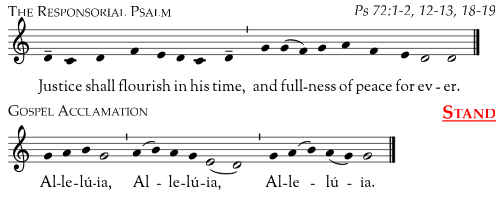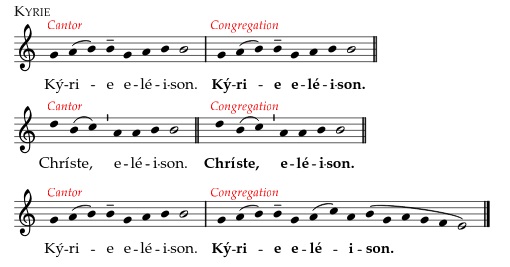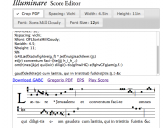Simplified Introit for Laetare Sunday Extraordinary form
-
Hi, I would like to ask for a volunteer who would check out my arrangement of the Introit for Laetare Sunday. My scola only has an hour to practice and the Introit in the Liber is much too difficult for such a short amount of time which also will need to include some practice for other Mass parts and Motets. I created it on MuseScore. I am a novice user and I know that modern notation does not convey the nuances of chant but I need it to be easy enough for different levels of musicians to learn. I did a combination of the original from the Liber and recto tono style. If you would like to help me please respond to this message. Claire Cavoto, in PA
-
I would encourage you to post your piece here. Typically in cases like this, it's done that way, so that many users can pitch in comments on it, and it would also be more useful to users down the road looking for similar things.
-
Ok, I've attached it below. Hopefully it will come through as a pdf. Thanks.

 Laetare Sunday.pdf23K
Laetare Sunday.pdf23K -
If there are going to be barlines "Lae-| ta-|re Je-| rusalem" &c. might avoid a little confusion.
-
Thanks for the tip, I'll see if there is an option to add bars in text. There wasn't a no bar line option for notation in MuseScore as far as I can see. I would have done it without bar lines for the notation. I'm not sure I can add them to the text with that software.
-
You might even find it helpful to adjust the measures with custom time to make each measure be a phrase instead of 4/4. It makes it much easier to read, more closely mimics the chant, and is easily possible in MuseScore, I've done it many times.Thanked by 1CCooze
-
A few examples of what I mean (these weren't done in MuseScore, but I've been able to do the same thing within MuseScore). Note how the bars are used to denote phrases, like in chant, not a strict time.
If you wanted, you could even remove the stems from the notes if you wanted to emulate chant notation even more. Also easy in MuseScore. Just right click on the staff, and go into stave settings, or something like that (I don't have it installed on the computer in front of me) and uncheck the appropriate boxes.


 psalm and al.png504 x 202 - 23K
psalm and al.png504 x 202 - 23K
 kyrie.png510 x 267 - 29K
kyrie.png510 x 267 - 29K -
To the music: mode of the "antiphon" (sounds like c hypomixolydian / mode 8) doesn't match mode of the psalm verse (c lydian / mode 5). That sounds strange for me.Thanked by 1Richard Mix
-
Archanggab, I don't at all advocate duplicating bars in the text underlay; merely pointing out that placing an anacrucis right after a bar line instead of before doesn't make your score easier to read. Have you surveyed existing simple introits already, for example Weber's?
-
Richard, he specified this is for the EF. He can't use English propers... Unless Weber's book includes Latin propers also (I never purchased a copy).
Didn't Rice write a bunch of simple Latin Propers last year? -
Hi Ben, I love the look of your scores but I have not been able to eliminate the bar lines. There is a Liturgical Unmetrical template. When I copied the score to that template I wound up with a note in each measure and couldn't get rid of the measure bars. I could not find a template that was only a treble clef with staff and no bar line.
-
Hi igneus, the mode mix did concern me too but did like that it was simple and syllabic. I may still change it. Our rehearsal is Sunday so I need it soon. The psalm verse in the Liber sounds quite contrasting to the antiphon which is one reason I thought I'd try it.
-
Hi Claire,
If the Latin wheel really hasn't been already invented, the next steps to consider are 1) solo cantor for the introit (choir on verse & GP), 2)(shudder, shudder) Rossini, 3) If the schola has a 5 year plan, simplification with reciting tones but keeping a few characteristics of the chant and cadential formulas of the mode that will pay later dividends. I can't teach you to make time signatures in Musescore, but if you copy this
Læ(f)ta(ixfigh)re(g_f) * Je(f)ru(g)sa(h)lem:(jj;)
et(jr) conventum faci-()te(jjj h_i_h_.;)
om(h)nes(jkjz) qui(ixir) diligi()-tis(g!hwiHG) e(fghvGFg)am(g.f.:)
gau(f)de(h)te(jr) cum lætitia, qui in tristitia() fu(k)is(j)tis:(j.:) &c
into a Gregorio editor like this one, you get something like this:
 Screen Shot 2016-02-23 at 7.03.08 PM.png695 x 544 - 87K
Screen Shot 2016-02-23 at 7.03.08 PM.png695 x 544 - 87K -
Thanks Richard, I'd like to explore the Gregorio editor more and try out your code. Your suggestion for keeping the chant and cadential formulas really appeals to me. I do need to keep it fairly simple this time since our rehearsal time is limited to one hour this Sunday. We usually practice before Mass but there is an Ordinary Form Mass prior to the EF on Latare Sunday, so we can't practice that day.
-
If you do use the score you wrote up, I would suggest F#s in the verse + G.P.
If you're looking to stay with something similar to what you wrote, I jotted this out in Finale real quick.
It might not be of any interest to you, which is totally fine, but just another simple option.
(the verse + GP are the same as from the Liber, and it looked as though you wanted the first 2 words to remain true to the Gregorian, so I just connected the dots in a similar manner.)
 Untitled1.pdf79K
Untitled1.pdf79K -
Thanks CCooze. I'd like to see what you jotted down. I have Finale notepad on my computer too so I think I can read what you did.
-
There should be a pdf file at the bottom of my post.Thanked by 1archanggab
-
Archanggb,
I'd be happy to reinstall musescore and walk you through removing the bars, if you'd like. Let me know!Thanked by 1archanggab -
Thanks Ben, any pointers you can give will be appreciated.Thanked by 1Ben
-
@archanggab
Here you go: Chant in MuseScore - Youtube Playlist
If anyone can think of anything else that'd be helpful to add, let me know and I'll make more.Thanked by 1archanggab
Welcome to the MusicaSacra Forum!
To participate in the discussions on Catholic church music, sign in or register as a forum member, The forum is a project of the Church Music Association of America.
Categories
- All Discussions21,096
- General Music Discussion8,211
- Job Openings197
- Management of Music Programs850
- Choral Matters532
- Church Documents and Rubrics524
- CMAA Notes301
- Events716
- For Newcomers: Read First26
- Sacred Polyphony546
- Hymnody872
- Gregorian Chant: General2,697
- ↳ Graduale Romanum and Liber Usualis368
- ↳ Graduale Simplex60
- ↳ Semiology63
- Vernacular Plainsong696
- Anglican Use and Anglican Chant68
- Organ, Other Instruments and Repertoire435
- New Composition/Works in Progress1,290
- Recordings230
- Music for Hispanic Ministry159
- Music Education: Children211
- Music Education: General222
- News Items245
- Positions Wanted2
- General Discussion: Catholicism739
- Amusements177
- General Discussion1,033
- Opinions117




